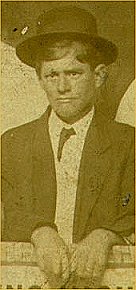Tom Brown (jazz musician)
Tom P. Brown (* 3. June 1888 in New Orleans , Louisiana ; † 25. March 1958 in New Orleans), called Red Brown, was an American jazz - trombonist and big band leader of the early New Orleans jazz . He was also a bass player.
Brown began like many New Orleans musicians in the bands of Papa Jack Laine (and in that of the trumpeter Frank Christian ), but led his own bands from around 1910. Their music (early jazz) was then known as "hot ragtime" or "ratty music". In early 1915 the vaudeville dancer Joe Frisco heard him and invited her to Chicago : In May 1915 “Tom Brown's Band from Dixieland” began to play in “Lamb's Cafe” ( Ray Lopez , cornet and manager, Gussie Mueller clarinet , replaced shortly after by Larry Shields , Arnold Loyacano piano and bass, Billy Lambert drums). They were the first band in which it can be proven that their music was publicly referred to as jazz (or as it was written Jass).
According to interviews with Brown, this was an attempt by the Chicago unions to defame the band as it became increasingly popular (the band members were not in the union). They patrolled with posters like “Don't patronize this Jass Music” (don't support this “bang music”). "Jass" was a word with a sexual meaning at the time and was supposed to connect Brown's band with the brothels in Storyville , New Orleans.
The attempt had the opposite effect - people became curious and flocked to the band, which Brown promptly renamed “Brown's Jass Band”. However, as a precaution, they were advertised in the newspapers as "Brown's Jab Band" (or Jad Band). Brown later claimed to have been the first white jazz band to go north. He was well aware that the original Creole Orchestra by Bill Johnson was already there. The band performed successfully for four months in Chicago and another four months in New York before returning to New Orleans (February 1916).
When New York theater agents asked him shortly afterwards about a “Jass” band, he recommended “Stein's Dixieland Jazz Band”, which played in Chicago. They gratefully accepted the offer from New York (without Johnny Stein , who was contractually bound) and called themselves there " Original Dixieland Jass Band " (ODJB) under the leadership of Nick LaRocca . Brown himself also went to New York in 1916, where his band played as "Five Rubes" in a revue at the Century Theater. In October they exchanged clarinetists with the ODJB (Brown received Alcide Nunez , LaRocca received Shields for it). When the band broke up, Nunez and the drummer Ragbaby Stevens went to Bert Kelly , whose band the ODJB replaced in 1918 with their successful performance in the restaurant "Reisenwebers". Brown himself worked freelance in New York and then joined Harry Yerkes' band, where Alcide Nunez also played from the beginning of 1920. He also played in vaudeville theaters.
In 1921 Brown returned to Chicago, where he played and recorded with Ray Miller's Black and White Melody Boys. He also led his own band with his younger brother Steve Brown , a bassist. In the mid-1920s he returned to New Orleans, where he played with the bands of Johnny Bayersdorffer ( and his Jazzola Novelty Orchestra ) and Norman Brownlee (of which there are also recordings). During the Depression, in addition to playing in local bands, Brown repaired radios and opened a music store and junk shop. In the 1950s he played in the Dixieland Revival, for example, in the band of Johnny Wiggs and recorded a few months before his death. At that time there was also a remarkable encounter with Nick LaRocca on a TV show, in which they were supposed to exchange memories about the beginnings of jazz. Instead, it turned into a tangible argument about the first use of the word jazz (there was even a dispute in court). In the 1950s, Brown first recorded under his own name.
Web links
Remarks
- ↑ Band leader Bert Kelly had poached Mueller
- ↑ So Brown in a later interview. The course of history is disputed between him and LaRocca
| personal data | |
|---|---|
| SURNAME | Brown, Tom |
| ALTERNATIVE NAMES | Brown, Tom P. |
| BRIEF DESCRIPTION | American jazz big band leader |
| DATE OF BIRTH | June 3, 1888 |
| PLACE OF BIRTH | New Orleans , Louisiana |
| DATE OF DEATH | March 25, 1958 |
| Place of death | New Orleans , Louisiana |
